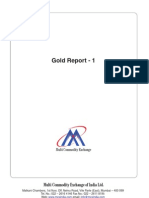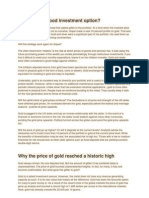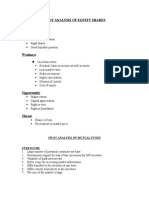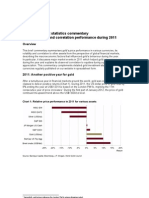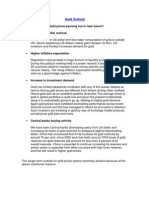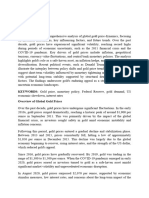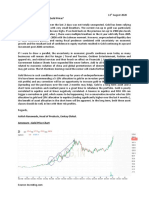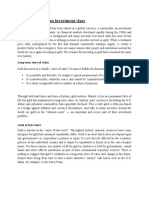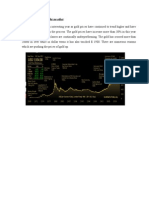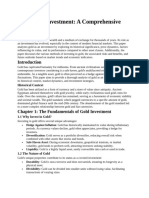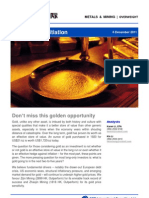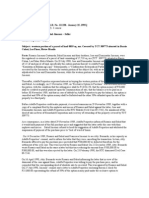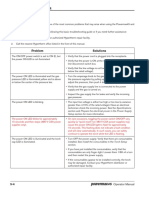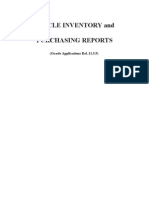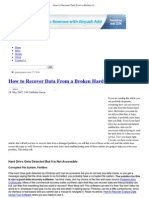MS 2012 Outlook: Precious Metals
MS 2012 Outlook: Precious Metals
Uploaded by
z2009z2009Copyright:
Available Formats
MS 2012 Outlook: Precious Metals
MS 2012 Outlook: Precious Metals
Uploaded by
z2009z2009Original Title
Copyright
Available Formats
Share this document
Did you find this document useful?
Is this content inappropriate?
Copyright:
Available Formats
MS 2012 Outlook: Precious Metals
MS 2012 Outlook: Precious Metals
Uploaded by
z2009z2009Copyright:
Available Formats
MS 2012 Outlook: Precious Metals
MS 2012 Outlook: Precious Metals Gold and silver are our preferred exposures given the heightened risks of a DM recession. Ongoing uncertainty surrounding the European sovereign debt crisis should be positive for safe haven investments. Moreover, an ongoing threat to the value and integrity of a major fiat currency (the euro), the renewed prospect of QE3 in the US and negative real interest rates are good news for gold/silver investment demand and prices in all currencies. Gold We remain bullish on price prospects over the medium term. Beyond the safe haven items noted above:1) The gold to oil ratio highlights that, on a long-term real purchasing power basis, gold is close to fair long-term value; 2) The prospect of sustained negative real interest rates reduces the opportunity cost of holding non-yielding assets. 3) Current USD strength is a headwind to USD gold prices, but our expectation of aggressive Fed easing and the adoption of QE3 in 1H12 is expected to boost golds performance materially. Silver Following a sharp correction in 2Q11, silver remains an attractively priced safe haven commodity relative to gold. However, silvers well attested volatility, its vulnerability to weakening industrial demand, and weaker supply credentials make it a less fundamentally supported market than gold. Platinum /Palladium We are less bullish on the Platinum Group Metals. Platinum lacks safe haven status and has limited investment demand. With jewelry and the automotive industry as key end markets, slowing global GDP and lower discretionary spending put demand at risk. Palladium is less exposed to the demand consequences of weakening EU auto demand. However, palladiums jewelry and investment demand base is even more limited offering little protection in a slowing growth environment. Gold: Preferred Metals Exposure Getting defensive: Gold remains our preferred exposure heading into 2012. Gold, and silver to a lesser extent, are viewed as safe havens and stores of value, as well as the closest thing to a global reserve currency. Not surprisingly, in analyzing commodity performance around previous US recessions, we find precious metals (especially gold) tend to outperform other commodities. Given the lack of progress in the Eurozone and US and our economists bearish economic forecasts, we feel it is prudent to position defensively, making gold an attractive investment option. Beyond macro weakness, heightened risk aversion and policy uncertainty should continue to benefit gold in 2012. We expect ongoing market uncertainty regarding the ability of European policy makers to deliver a credible shock and awe solution to the sovereign debt crisis will continue to be positive for gold investment demand over the coming year. Gold is once again close to long-term fair value, creating an attractive entry point. The fall in the goldto-oil price ratio highlights that on a long-term real purchasing power basis, gold is once again close to fair value, which should attract bargain hunters. We arent deterred by the recent sell
off as temporary price corrections are a normal occurrence during a bull market. The corrective price action since September has stalled the uptrend in gold, but has not reversed its primary direction. Such non-trend reversing price corrections are healthy and have been evident throughout the 2001-2011 bull market, especially since the acceleration in the uptrend from 2009. USD strength likely to be offset by aggressive Fed easing. Projected USD strength should be a headwind to short-term gold price performance. However, we expect an aggressive easing of financial conditions by the Fed in 1H12, including a heightened probability of QE3, to provide an offset. QE in its earlier manifestation was positive for gold and silver prices.
Gold: Uncertainty Over Macroeconomic Trends Is Key To Support Demand Risk aversion boosting investment demand. The lack of progress on the Eurozone debt crisis and US deficit reductions provided a major stimulus to investment demand for gold as a safe haven asset for much of 3Q11. Threats to major fiat currencies should drive additional buying.
With the Eurozone sovereign debt crisis moving from the periphery to the core (Italy, Spain), an ongoing threat to the value and integrity of a major fiat currency is positive for gold investment demand and prices in all currencies. Negative real interest rates increase appeal. The prospect of a long period of negative real interest rates is bullish for investment demand as it reduces the opportunity cost of holding a non-yielding asset. Supply Limited central bank selling. Central banks are sending strong positive signals to the gold market. Global net purchases of 100 tonnes in 1H11 accelerated the net buying trend that emerged in 2010. Despite the protracted crisis, European central banks have been notably absent as sellers, notwithstanding very elevated prices. Emerging market central banks continue to be net buyers, accelerating purchases during the course of 2011, despite persistently rising prices. Insufficient new production. Mine production is increasing once again, rising 6.2% YoY in 1H11. However, this new supply is insufficient to keep pace with the combined effects of investment demand, central bank buying and only modest growth in secondary supply
Silver: Safe Haven Status Should Reemerge, but Volatility Likely to Continue Higher volatility here to stay. The high level of volatility in silvers 2011 price performance has been nothing short of dramatic. The sharp rise in the silver price between late March and May caused the gold:silver ratio to narrow sharply, reaching its lowest point since October 1980 at 30:1. Following successive increases in the Comex margin requirements, the gold:silver ratio stabilized until the third week of September when a 23.4% fall in silver prices pushed the ratio back to the long-run average of 54:1 despite an 8.5% fall in gold prices. Silvers industrial exposure has jeopardized the gold-silver ratio. Silvers precious metal status and, therefore, its links with gold have traditionally been reinforced by investors preference to hedge systemic financial risk, rising inflationary pressures, and resurgent political risk through a cheaper vehicle with similar value storing characteristics as gold. However, mounting concerns about slowing industrial demand, a key end market, put silvers traditional links to gold under increasing pressure. Safe-haven status should be reinstated in 2012. Despite silvers relative underperformance vs. gold in 2H11, we expect the implied erosion of silvers status as a precious
metal safe haven to be temporary. 1) The recent weakness in silver prices should attract bargain hunters. If sovereign debt concerns persist, silvers potential as a cheap store of value is likely to overwhelm demand concerns, which appear to be mostly priced in. 2) Low opportunity cost. As with gold, an expected lengthy period of negative real interest rates should reignite investment demand for silver as a non-yielding asset, even in the absence of a renewed round of QE. 3) Slowing outflows from physically backed ETFs. An extended period of negative real interest rates will also be critical for quarantining the risk of large outflows of silver from physically backed ETFs. To date, recent evidence suggests that long liquidation pressures have been stronger in the paper silver market than in the physical investment market. Gold Silver Ratio
Platinum: Any Recovery Must be Led by Demand Supply While operational constraints remain a feature in the South African mining landscape, supply discipline is not on the agenda. Many of the large, medium and small cap platinum companies have near and mediumterm growth projects under active development. While slippage is likely, the lack of appetite for active supply discipline is a concern in a risky demand environment especially given the political constraints to cutting high-cost production.
Demand As industrial demand for platinum correlates to global GDP growth, we believe demand-side risk is skewed to the downside. Critically, European autos account for 22% of gross platinum demand, making this segment the single largest regional driver of demand. The nonauto global industrial segment represents 24% of platinum demand , and faces similar nearterm headwinds from slowing global GDP growth and industrial production. Jewelry demand a relative positive, but not enough to support prices. We expect jewelry demand in China to account for 22% of gross platinum demand in 2011and to remain a key price-elastic support for platinum demand. However, we do not think this component can drive up the price. A weaker supply and demand balance and a stronger USD potentially impair investor interest in platinum. Platinum could see some marginal investor buying given the increased appetite for precious metals as a safe haven asset. However, we expect any defensive buying to be limited and more than offset by poor fundamentals. Needless to say, we view gold as a far superior safe-haven asset, as demonstrated in 2008.
You might also like
- Dungeon Twister Glossary PDFDocument43 pagesDungeon Twister Glossary PDFMadWelshWizard100% (1)
- Paul Tudor Jones The Great Liquidity RaceDocument2 pagesPaul Tudor Jones The Great Liquidity RacePeter BullockNo ratings yet
- Book Review - World Religions - A Guide To The Essentials, 2nd EdDocument2 pagesBook Review - World Religions - A Guide To The Essentials, 2nd EdEaglemsian100% (2)
- Investing in GoldDocument19 pagesInvesting in Goldviny137100% (2)
- Gold Industry Report Featuring Goliath May 4 2021Document10 pagesGold Industry Report Featuring Goliath May 4 2021Chester Yukon GoldNo ratings yet
- RGSF Product Note Oct 2012 PDFDocument10 pagesRGSF Product Note Oct 2012 PDFinfosipriNo ratings yet
- Gold Commodity ProfileDocument38 pagesGold Commodity Profileraveendhar.k100% (3)
- Gold's Irrational Price Movement: Understanding GoldDocument7 pagesGold's Irrational Price Movement: Understanding GoldNamrata KanodiaNo ratings yet
- Gold Forecast 2010Document12 pagesGold Forecast 2010Mohamed Said Al-QabbaniNo ratings yet
- 1gold Report PDFDocument86 pages1gold Report PDFrahul84803No ratings yet
- GOLD - A Safe HavenDocument9 pagesGOLD - A Safe HavenAzeembhaiNo ratings yet
- Week in Review: Gold Fundamentals Are Intact. Current Prices Are A Buying Opportunity!Document26 pagesWeek in Review: Gold Fundamentals Are Intact. Current Prices Are A Buying Opportunity!Paolo GerosaNo ratings yet
- Will It Really Fall Further or It Will Bounce Back?Document13 pagesWill It Really Fall Further or It Will Bounce Back?shalmaNo ratings yet
- Gold Prices FluctuationsDocument6 pagesGold Prices Fluctuationskuldeep_chand10No ratings yet
- GoldDocument10 pagesGoldShikha TiwaryNo ratings yet
- (Kitco News) - Like A Prizefighter Who Has Taken A Few Upper Cut BlowsDocument3 pages(Kitco News) - Like A Prizefighter Who Has Taken A Few Upper Cut BlowsJohnson LiuNo ratings yet
- Ruling The Roost - Precious Metals: Thought PaperDocument6 pagesRuling The Roost - Precious Metals: Thought PaperPrashant UjjawalNo ratings yet
- Global Macro Daily LONDON Open (2014!01!16)Document14 pagesGlobal Macro Daily LONDON Open (2014!01!16)BlundersNo ratings yet
- Is Gold Still A Good Investment OptionDocument3 pagesIs Gold Still A Good Investment OptionSwati ShahNo ratings yet
- A Golden MulliganDocument14 pagesA Golden MulliganNick WeeksNo ratings yet
- Swot Analysis of Asset ClassesDocument5 pagesSwot Analysis of Asset ClassesRakkuyil Sarath33% (3)
- Industry Profile: (Type The Document Title)Document5 pagesIndustry Profile: (Type The Document Title)KumarKyNo ratings yet
- Swot Analysis of Equity SharesDocument6 pagesSwot Analysis of Equity SharesChristin MathewNo ratings yet
- GOLD - The Simple Facts: ViewpointDocument5 pagesGOLD - The Simple Facts: ViewpointjohnreidenbaughNo ratings yet
- Gold Market Us PDFDocument60 pagesGold Market Us PDFMohan RajNo ratings yet
- Gold Investment Statistics Commentary - WGCDocument8 pagesGold Investment Statistics Commentary - WGCjohnnilNo ratings yet
- Gold OutlookDocument5 pagesGold Outlookksat85No ratings yet
- Nhóm 3- KTCTQT Tổng hợp (1)Document15 pagesNhóm 3- KTCTQT Tổng hợp (1)Phan AnhNo ratings yet
- Gold N Silver Price Hikes!!Document27 pagesGold N Silver Price Hikes!!apurva2205No ratings yet
- Gold Public Monthly Commentary 2011 05Document3 pagesGold Public Monthly Commentary 2011 05Sara CostaNo ratings yet
- Will Gold Continue To Shine?: MarketDocument6 pagesWill Gold Continue To Shine?: MarketdpbasicNo ratings yet
- 8-22-11 Breakout in Precious MetalsDocument4 pages8-22-11 Breakout in Precious MetalsThe Gold SpeculatorNo ratings yet
- Gold As An Investment: By, 7th GroupDocument10 pagesGold As An Investment: By, 7th GroupBalamanichalaBmcNo ratings yet
- Commodities 2011 Craig DrakeDocument1 pageCommodities 2011 Craig DrakecsdrakeNo ratings yet
- Gold - Glittering Glittering More Than Ever Han EverDocument11 pagesGold - Glittering Glittering More Than Ever Han Evervibhach1No ratings yet
- Gold Market Forecast 2010Document8 pagesGold Market Forecast 2010Anonymous fE2l3DzlNo ratings yet
- Gold Investor Volume 3Document36 pagesGold Investor Volume 3Hung NguyenNo ratings yet
- Impact of Gold Prices On World EconomyDocument19 pagesImpact of Gold Prices On World EconomyGagan Preet Kaur100% (1)
- Worried About The Fall in Gold Price?: Ashish Ranawade, Head of Products, Emkay Global. Annexure: Gold Price ChartDocument1 pageWorried About The Fall in Gold Price?: Ashish Ranawade, Head of Products, Emkay Global. Annexure: Gold Price ChartspeedenquiryNo ratings yet
- Gold in The Investment Portfolio: Frankfurt School - Working PaperDocument50 pagesGold in The Investment Portfolio: Frankfurt School - Working PaperSharvani ChadalawadaNo ratings yet
- The Impact of Inflation and Deflation On The Case For GoldDocument48 pagesThe Impact of Inflation and Deflation On The Case For GoldSuchit HowaleNo ratings yet
- Basics of Gold As An Investment ClassDocument6 pagesBasics of Gold As An Investment Classanandyadav_imgNo ratings yet
- InvestmentDocument9 pagesInvestmentInzamam ul haqNo ratings yet
- Scotia Mocatta - Gold 2012 Forecast 11-01-11Document13 pagesScotia Mocatta - Gold 2012 Forecast 11-01-11Bullwinkle2No ratings yet
- Alch29 LeasesDocument3 pagesAlch29 LeasesAmol KulkarniNo ratings yet
- A Study On Role of Gold Portfolio AllocationDocument6 pagesA Study On Role of Gold Portfolio AllocationNITINNo ratings yet
- Gold: - A Commodity Like No OtherDocument6 pagesGold: - A Commodity Like No OtherVeeresh MenasigiNo ratings yet
- Investment in GoldDocument45 pagesInvestment in GoldsagarsanjanaNo ratings yet
- The Article Identifies Five Factors Affecting The World Demand For Gold. List at Least Two of ThemDocument4 pagesThe Article Identifies Five Factors Affecting The World Demand For Gold. List at Least Two of ThemAmit JindalNo ratings yet
- Gold ResearcherDocument84 pagesGold ResearchergoldresearcherNo ratings yet
- Standard Jan042012Document6 pagesStandard Jan042012Mohmad AnsaryNo ratings yet
- GOLDDocument4 pagesGOLDajjus96No ratings yet
- GDT Q1 2013Document28 pagesGDT Q1 2013Anshuljn11No ratings yet
- Gold Sector Initiation: Don't Miss This Golden OpportunityDocument44 pagesGold Sector Initiation: Don't Miss This Golden OpportunityDavid QuahNo ratings yet
- Gold-Physical Vs MF DemystifiedDocument4 pagesGold-Physical Vs MF Demystifiedmcube4uNo ratings yet
- Investment Thesis: GLD-Time To Turn Greedy As Everyone T Turn Greedy As Everyone Turns FearfulDocument3 pagesInvestment Thesis: GLD-Time To Turn Greedy As Everyone T Turn Greedy As Everyone Turns FearfulAnuradhaNo ratings yet
- Gold Store of ValueDocument9 pagesGold Store of ValueHarshitha DammuNo ratings yet
- Week Summary: Macro StrategyDocument10 pagesWeek Summary: Macro StrategyNoel AndreottiNo ratings yet
- Investor'S Guide: by Jeff Clark, Editor of Big GoldDocument12 pagesInvestor'S Guide: by Jeff Clark, Editor of Big GoldaldilnojinjaloNo ratings yet
- How to Invest in Gold: A guide to making money (or securing wealth) by buying and selling goldFrom EverandHow to Invest in Gold: A guide to making money (or securing wealth) by buying and selling goldRating: 3 out of 5 stars3/5 (1)
- PDF Minimum Age For Criminal ResponsibilityDocument4 pagesPDF Minimum Age For Criminal ResponsibilitySenyora SunNo ratings yet
- Life Skills For Self-Directed Learning: Personal DevelopmentDocument11 pagesLife Skills For Self-Directed Learning: Personal DevelopmentAlwina JarabejoNo ratings yet
- Adelfa Properties Vs CA DigestDocument3 pagesAdelfa Properties Vs CA DigestTon Baylas Palisada100% (3)
- Office SuppliesDocument465 pagesOffice SuppliesHemanth ReddyNo ratings yet
- Dc16rn3523 CK Products SPAR Release 073.Xxx.086.15410Document19 pagesDc16rn3523 CK Products SPAR Release 073.Xxx.086.15410cristian_becheverriaNo ratings yet
- Daily Dairy 23-10-2023Document3 pagesDaily Dairy 23-10-2023Afaq AhmedNo ratings yet
- HOLIDAYS AND CELEBRATION - Angol TételDocument2 pagesHOLIDAYS AND CELEBRATION - Angol TételAlexa c:No ratings yet
- Used 2009 JuneDocument47 pagesUsed 2009 JunedegrisyNo ratings yet
- OM 805780r2 PMX45 Change1Document1 pageOM 805780r2 PMX45 Change1Eduardo BarbosaNo ratings yet
- Chapter 8: Recursion: SolutionsDocument31 pagesChapter 8: Recursion: SolutionsEric Martin100% (2)
- Lecture 02 Electrical Networks Transfer FunctionDocument18 pagesLecture 02 Electrical Networks Transfer FunctionRammay SbNo ratings yet
- BSBMKG417 Assessment Task-1Document2 pagesBSBMKG417 Assessment Task-1Teerapol KhoonburanNo ratings yet
- Zweber CV 2024Document4 pagesZweber CV 2024api-632375384No ratings yet
- Pme 1977-2003Document158 pagesPme 1977-2003ese100% (1)
- Case Presentation On "Congestive Heart Failure" General ObjectiveDocument7 pagesCase Presentation On "Congestive Heart Failure" General ObjectiveLorlaine Quilitano PeñarandaNo ratings yet
- Consumer Preference Towards Different Branded Sports ShoesDocument11 pagesConsumer Preference Towards Different Branded Sports ShoesAnushka KharatNo ratings yet
- BULL10 Upload & Print Sept 2020Document230 pagesBULL10 Upload & Print Sept 2020Ayn HinNo ratings yet
- Song The Hall of Fame Activities Promoting Classroom Dynamics Group Form - 43976Document2 pagesSong The Hall of Fame Activities Promoting Classroom Dynamics Group Form - 43976lizandrewNo ratings yet
- Ali Baba and The Forty ThievesDocument5 pagesAli Baba and The Forty ThievesUncil StylerNo ratings yet
- PHAN Catalogue EN 2018Document2 pagesPHAN Catalogue EN 2018anhhp8xNo ratings yet
- 02 Van Der VorstDocument12 pages02 Van Der VorstSumeet GillNo ratings yet
- Lens Design PDFDocument11 pagesLens Design PDFNaga LakshmaiahNo ratings yet
- Oracle Inventory and Purchasing ReportsDocument29 pagesOracle Inventory and Purchasing Reportsspan_hgoiNo ratings yet
- How To Recover Data From A Broken Hard DriveDocument73 pagesHow To Recover Data From A Broken Hard DriveTasda VongNo ratings yet
- HM Som - GuideDocument60 pagesHM Som - GuideAshley SubethaNo ratings yet
- RequestDocument3 pagesRequestNgọc TrangNo ratings yet
- Resume To AllDocument2 pagesResume To Allapi-353708744No ratings yet
- Folleto de Las Características Del Programa de FormaciónDocument2 pagesFolleto de Las Características Del Programa de FormaciónacilegnaNo ratings yet









